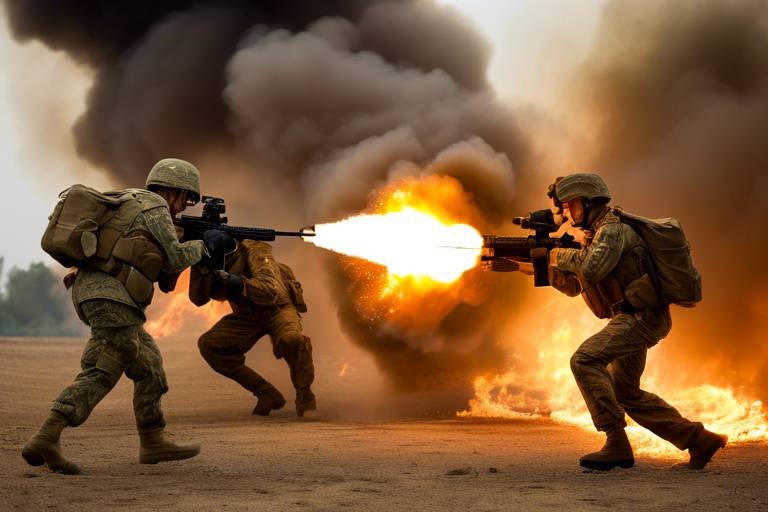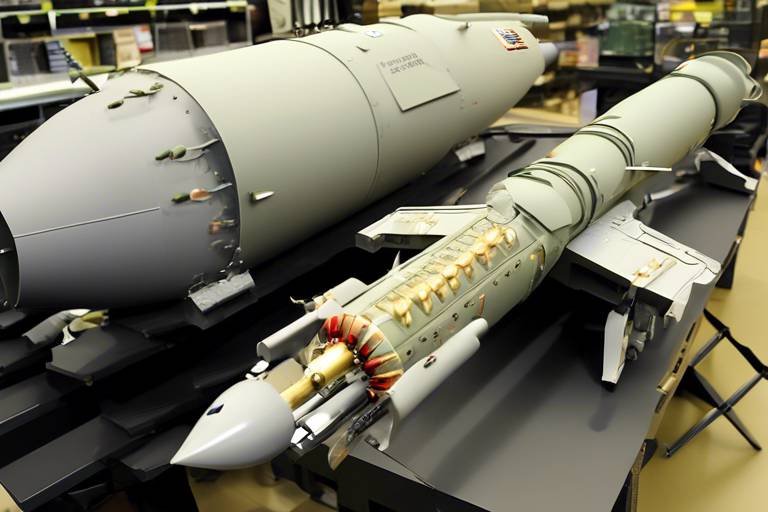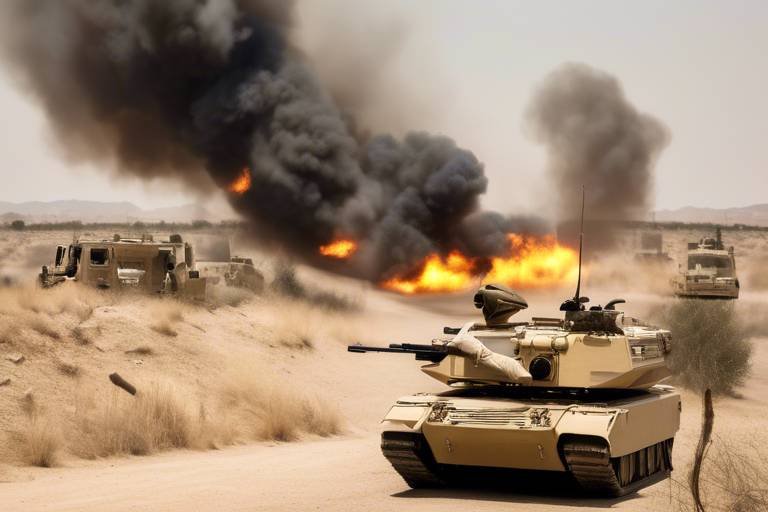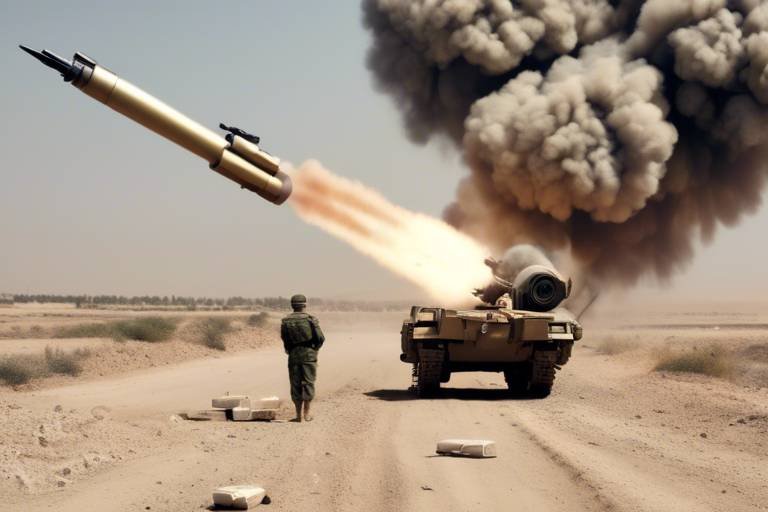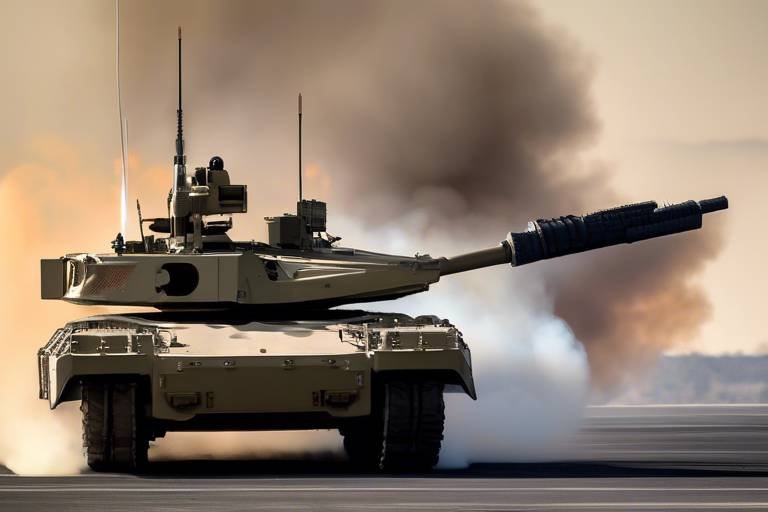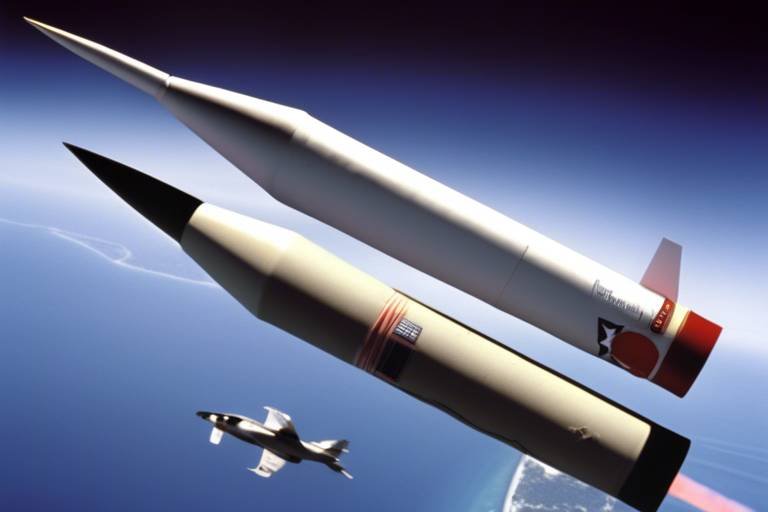The Role of Firepower in Military Transformation
In the ever-evolving landscape of warfare, the concept of firepower has undergone a remarkable transformation. From the rudimentary weapons of ancient civilizations to the sophisticated arsenal of modern militaries, advancements in firepower have significantly influenced military strategies, technologies, and overall effectiveness in combat. As we delve into this topic, we will explore how firepower has not only shaped historical conflicts but also continues to redefine the dynamics of warfare today.
Historically, firepower was primarily synonymous with the ability to inflict damage through conventional weaponry. The introduction of gunpowder marked a pivotal moment, allowing armies to engage in battles with unprecedented lethality. Fast forward to the present, and we see a dramatic shift towards precision and efficiency. This evolution has led to the development of advanced weapon systems that can strike targets with remarkable accuracy, minimizing collateral damage and maximizing operational effectiveness.
Today, the role of firepower extends beyond mere destruction. It encompasses a wide array of technologies that enhance situational awareness, intelligence gathering, and strategic planning. For instance, the integration of unmanned aerial vehicles (UAVs) has revolutionized reconnaissance missions, enabling military forces to gather real-time data without putting personnel at risk. This shift towards technology-driven warfare underscores the importance of firepower in achieving tactical superiority.
Moreover, as we examine the contemporary battlefield, we cannot overlook the influence of cyber warfare. In this digital age, the ability to disrupt an enemy's communication and information systems can be just as impactful as traditional firepower. The synergy between kinetic and cyber capabilities has created a new paradigm in military strategy, where the notion of firepower now includes information dominance.
As we move forward, the implications of these advancements are profound. Armed forces worldwide are compelled to adapt their strategies to leverage the full spectrum of firepower available to them. This ongoing transformation not only enhances combat effectiveness but also raises critical questions about the ethical use of advanced technologies in warfare. How do we balance the need for military superiority with the moral responsibilities that come with such power?
In conclusion, the role of firepower in military transformation is a multifaceted topic that encompasses historical evolution, technological advancements, and strategic implications. As we continue to witness the rapid development of new weapon systems and tactics, it is essential to consider how these changes will shape the future of warfare and the responsibilities that accompany them.
- What is firepower in military terms? Firepower refers to the capability of a military force to deliver effective fire against an enemy, encompassing various weapons and technologies.
- How has technology changed firepower? Technological advancements have led to the development of precision-guided munitions, drones, and cyber capabilities, enhancing the effectiveness and efficiency of military operations.
- What role do drones play in modern warfare? Drones provide real-time intelligence and precision strike capabilities, significantly altering the dynamics of combat and operational planning.
- What are the ethical concerns surrounding modern firepower? Ethical considerations include civilian casualties, accountability for drone strikes, and the moral implications of employing advanced technologies in warfare.
Historical Evolution of Firepower
The is a fascinating journey that mirrors the development of human ingenuity and the relentless pursuit of dominance in warfare. From the rudimentary tools of ancient combat to the sophisticated weaponry of today, firepower has transformed military strategies and influenced the outcomes of countless battles. In ancient times, armies relied heavily on bludgeoning weapons and projectiles such as slings and bows. These early forms of firepower were limited in range and impact, often requiring soldiers to engage in close-quarters combat.
As civilizations advanced, so did their weaponry. The invention of gunpowder in the 9th century revolutionized warfare, leading to the development of cannons and firearms. This marked a significant turning point, as armies could now strike from a distance, altering the dynamics of battle. The introduction of rifled barrels in the 19th century further enhanced accuracy and range, allowing for more devastating effects on the battlefield.
Throughout the 20th century, the evolution of firepower accelerated dramatically. The World Wars witnessed unprecedented advancements in military technology, with tanks, aircraft, and artillery becoming central to military operations. The destructive capabilities of these weapons not only changed how wars were fought but also led to a reevaluation of military strategies. For instance, the use of blitzkrieg tactics during World War II showcased the effectiveness of combining air and ground firepower to achieve swift victories.
In the contemporary era, we have entered a new phase characterized by precision and lethality. The development of guided munitions and smart bombs has enabled armed forces to strike targets with remarkable accuracy, minimizing collateral damage while maximizing effectiveness. This shift towards precision warfare has been further enhanced by the integration of advanced technologies such as satellites and real-time data analytics, allowing for informed decision-making on the battlefield.
To illustrate the progression of firepower throughout history, consider the following table:
| Time Period | Type of Firepower | Key Developments |
|---|---|---|
| Ancient Times | Bludgeoning Weapons & Projectiles | Swords, Bows, Slings |
| 9th Century | Gunpowder Weapons | Cannons, Early Firearms |
| 19th Century | Rifled Firearms | Improved Accuracy and Range |
| 20th Century | Tanks and Aircraft | Blitzkrieg Tactics, Combined Arms |
| 21st Century | Precision Munitions | Guided Bombs, Smart Weapons |
As we look to the future, it’s clear that the evolution of firepower will continue to shape military strategies. The ongoing development of unmanned systems and cyber capabilities suggests a shift towards increasingly sophisticated forms of warfare. Understanding this historical context is crucial for grasping the current role of firepower in military operations, as it not only informs present strategies but also prepares us for the challenges ahead.
Technological Advancements in Weaponry
The landscape of military firepower has undergone a remarkable transformation over the past few decades, driven by rapid technological advancements. From the days of rudimentary weapons to today's sophisticated systems, the evolution of weaponry has not only changed how wars are fought but also how strategies are formulated. Imagine a battlefield where precision and speed reign supreme, where the margin for error is razor-thin, and where technology dictates the pace of conflict. This is the reality of modern warfare, and it is largely due to innovations in military firepower.
One of the most significant breakthroughs has been the development of precision-guided munitions (PGMs). These advanced weapons systems are designed to strike targets with pinpoint accuracy, minimizing collateral damage and maximizing effectiveness. Unlike traditional bombs that rely on sheer explosive power, PGMs use advanced targeting systems, including GPS and laser guidance, to ensure they hit exactly where intended. This shift not only enhances the lethality of military operations but also raises the stakes in terms of ethical considerations and accountability.
Moreover, the rise of unmanned systems, particularly drones, has revolutionized how firepower is deployed. Drones are no longer just tools for surveillance; they have evolved into formidable weapons platforms capable of carrying out precision strikes without risking human lives. This capability allows military forces to engage targets in hostile environments with unprecedented safety and efficiency. The integration of drones into military operations showcases how technology is redefining the concept of firepower and altering the dynamics of warfare.
Another noteworthy advancement is the emergence of directed energy weapons. These futuristic systems, such as laser weapons, promise to change the face of military engagements by providing a means to engage multiple targets rapidly and with minimal cost per shot. Imagine a scenario where a military unit can neutralize incoming threats with a beam of light—this is no longer science fiction but a tangible reality being explored by armed forces around the globe.
The impact of these technological advancements extends beyond mere hardware; they influence military doctrine and strategy as well. As armed forces incorporate new technologies, they must adapt their operational frameworks to leverage these advancements effectively. For instance, the ability to conduct network-centric warfare allows for real-time data sharing and collaborative decision-making, fundamentally altering how military campaigns are planned and executed.
In summary, the technological advancements in weaponry are reshaping military firepower in profound ways. From precision-guided munitions to unmanned systems and directed energy weapons, these innovations are enhancing the effectiveness of armed forces while also posing new ethical and strategic challenges. As we look to the future, it is clear that technology will continue to play a pivotal role in defining the nature of warfare, necessitating ongoing adaptation and evolution within military organizations.
- What are precision-guided munitions?
Precision-guided munitions are advanced weapons designed to strike targets with high accuracy, reducing collateral damage. - How have drones changed military operations?
Drones provide real-time intelligence and precision strike capabilities, allowing for safer and more effective military engagements. - What are directed energy weapons?
Directed energy weapons use focused energy, such as lasers, to engage and neutralize targets quickly and efficiently. - How does technology influence military strategy?
Technological advancements necessitate changes in military doctrine, enabling forces to leverage new capabilities for strategic advantages.
Impact of Drones on Firepower
The advent of drones has dramatically transformed the landscape of military firepower, marking a significant shift in how modern warfare is conducted. These unmanned aerial vehicles (UAVs) are no longer just tools for reconnaissance; they have evolved into powerful platforms capable of delivering precision strikes with remarkable accuracy. Imagine a hawk soaring high above the battlefield, its keen eyes spotting targets while remaining out of reach of enemy defenses. This analogy captures the essence of drone warfare, where surveillance and strike capabilities are seamlessly integrated.
One of the most compelling aspects of drones is their ability to provide real-time intelligence. This capability allows military commanders to make informed decisions on the fly, adapting their strategies based on the evolving dynamics of the battlefield. For instance, during conflicts in regions like the Middle East, drones have been utilized to gather crucial information about enemy movements and positions. This intelligence can then be used to plan effective strikes, minimizing collateral damage and maximizing operational success.
Moreover, drones have significantly enhanced the effectiveness of firepower by reducing the risks to personnel. In traditional warfare, deploying ground troops to engage in combat often meant exposing them to life-threatening situations. Drones change this narrative by allowing military forces to strike from a distance, keeping soldiers out of harm's way. This shift not only preserves lives but also offers a tactical advantage, as operators can engage targets without being physically present on the battlefield.
However, the integration of drones into military operations is not without its challenges. The reliance on UAVs raises questions about operational security and the potential for misuse. For example, the risk of hacking or jamming drone signals could compromise missions and lead to unintended consequences. Additionally, the use of drones in combat operations has sparked debates about the ethics of warfare, particularly concerning civilian casualties. As drones become more prevalent, the military must navigate these complexities to ensure responsible use.
When considering the future of military firepower, it's essential to recognize that drones will continue to play a pivotal role. With advancements in technology, we can expect to see drones equipped with improved sensors, longer flight times, and enhanced autonomous capabilities. These developments will further amplify their impact on firepower, enabling armed forces to conduct operations with even greater precision and efficiency.
In summary, the impact of drones on firepower is profound and multifaceted. They not only enhance the effectiveness of military operations but also introduce new challenges that must be addressed. As we look ahead, it is clear that drones will remain a cornerstone of modern military strategy, reshaping the way conflicts are fought and won.
- What are the primary advantages of using drones in military operations?
Drones provide real-time intelligence, reduce risks to personnel, and enable precision strikes, making them invaluable in modern warfare. - How do drones affect the ethical considerations of warfare?
The use of drones raises concerns about civilian casualties and accountability, prompting ongoing debates about the morality of drone strikes. - What future developments can we expect in drone technology?
Future advancements may include improved sensors, longer flight times, and enhanced autonomous capabilities, further increasing their effectiveness in military operations.
Ethical Considerations of Drone Warfare
Drone warfare has emerged as a powerful tool in modern military operations, but with great power comes great responsibility. The ethical implications surrounding the use of drones are profound and multifaceted, raising questions that challenge our understanding of warfare itself. One of the most pressing issues is the potential for civilian casualties. Unlike traditional combat scenarios, where the battlefield is often clearly defined, drone strikes can occur in populated areas, leading to tragic unintended consequences. How do we justify the loss of innocent lives in the pursuit of military objectives?
Moreover, the accountability for drone strikes is a significant concern. When a drone operator is thousands of miles away, sitting in a control room, the emotional and psychological distance can create a disconnect from the realities of warfare. This raises questions about who is held accountable when things go wrong. Is it the operator, the commanding officers, or the policymakers who authorized the strike? The lack of transparency in drone operations often obscures these lines of responsibility, making it difficult to hold anyone accountable.
Another ethical consideration involves the disproportionate use of force. Drones, equipped with precision-guided munitions, can deliver devastating strikes with pinpoint accuracy. However, this precision can lead to an over-reliance on drone warfare as the primary means of combat. Military leaders may be tempted to opt for drone strikes over more traditional methods, potentially leading to a cycle of violence that could have been avoided through diplomatic means. Is it ethical to choose a path of least resistance that may perpetuate conflict rather than seek peaceful resolutions?
Furthermore, the psychological impact on drone operators cannot be overlooked. While they may be physically removed from the battlefield, the mental toll of conducting strikes and witnessing the aftermath can lead to significant emotional distress. Reports of post-traumatic stress disorder (PTSD) among drone operators are increasingly common, challenging the notion that distance equates to detachment from the horrors of war. This raises a critical question: Are we, as a society, prepared to address the mental health ramifications of this new form of warfare?
In considering these ethical dilemmas, it is essential to foster a dialogue that includes not only military personnel but also policymakers, ethicists, and the general public. The implications of drone warfare extend beyond the battlefield and into the realm of international law and human rights. As we move forward, we must grapple with the complexities of drone warfare and strive to create frameworks that prioritize ethical considerations while maintaining national security.
In conclusion, the ethical considerations of drone warfare are intricate and demand careful examination. As technology continues to evolve, so too must our understanding of its implications. By engaging in thoughtful discussions and seeking to balance military effectiveness with moral responsibility, we can navigate the challenges posed by drone warfare in a way that respects human dignity and upholds ethical standards.
- What are the main ethical concerns regarding drone warfare? The primary concerns include civilian casualties, accountability for strikes, disproportionate use of force, and the psychological impact on operators.
- How do drone strikes affect civilian populations? Drone strikes can lead to unintended civilian casualties, raising moral questions about the justification of such actions in populated areas.
- Who is held accountable for drone strikes that result in civilian deaths? Accountability can be complex, involving operators, commanding officers, and policymakers, often obscured by the lack of transparency in operations.
- Can the use of drones lead to an over-reliance on military force? Yes, the precision of drones may encourage military leaders to choose drone strikes over diplomatic solutions, potentially escalating conflicts.
- What mental health issues do drone operators face? Many drone operators report experiencing PTSD and other mental health challenges due to the nature of their work, despite being physically removed from combat zones.
Future of Drone Technology
The is not just a fleeting trend; it’s a profound transformation that is reshaping military operations and strategies across the globe. As we look ahead, the advancements in drone capabilities promise to enhance not only the effectiveness of armed forces but also the very nature of warfare itself. Imagine a battlefield where drones are not merely tools but integral components of a larger, interconnected system. This vision is becoming a reality as innovations in artificial intelligence (AI), machine learning, and autonomous systems continue to evolve.
One of the most exciting prospects is the development of swarm technology, where multiple drones can operate in unison to overwhelm enemy defenses or gather intelligence. Just like a flock of birds moving in perfect synchronization, these drone swarms can adapt to changing situations, making them incredibly versatile in combat scenarios. This capability not only enhances tactical flexibility but also poses significant challenges for adversaries who must defend against a multitude of simultaneous threats.
Moreover, the integration of AI-driven decision-making systems into drones is set to revolutionize how military operations are conducted. Imagine drones that can analyze data in real-time, making split-second decisions based on the battlefield environment. This leap in technology could lead to unprecedented levels of precision in targeting, minimizing collateral damage and increasing mission success rates. However, this raises important questions about the role of human oversight in military decisions. Will we be comfortable allowing machines to make life-and-death choices on our behalf?
As we consider the implications of these advancements, it's essential to address the potential ethical dilemmas they introduce. The use of drones, particularly armed ones, has already sparked debates about accountability and civilian safety. If drones become more autonomous, who is responsible for their actions? This question will be crucial as military forces around the world adopt these technologies. The balance between leveraging advanced capabilities and adhering to ethical standards will be a tightrope walk for military leaders.
In addition to ethical concerns, the will also see enhancements in stealth capabilities. As adversaries develop counter-drone technologies, the race for superiority will intensify. Future drones will likely incorporate advanced materials and designs that make them less detectable to radar and other tracking systems. This stealth advantage will allow military forces to conduct operations with greater secrecy and efficiency.
Furthermore, the potential for interoperability among drones and other military assets cannot be overlooked. As armed forces increasingly rely on a networked approach, the ability for drones to communicate seamlessly with ground troops, naval vessels, and aerial support will enhance operational efficiency. This interconnectedness will enable real-time sharing of intelligence, paving the way for quicker and more informed decision-making.
In conclusion, the future of drone technology is poised to redefine the landscape of modern warfare. With advancements in swarm technology, AI integration, stealth capabilities, and interoperability, drones will become even more critical in military operations. However, as we embrace these innovations, we must also grapple with the ethical implications and ensure that technological advancements do not outpace our moral responsibilities. The dialogue surrounding these issues will be essential as we navigate this new frontier of military power.
- What are the main advancements expected in drone technology?
Future advancements include swarm technology, AI-driven decision-making, enhanced stealth capabilities, and improved interoperability with other military assets. - How will drones impact military ethics?
The rise of autonomous drones raises important ethical questions regarding accountability, civilian safety, and the role of human oversight in military decisions. - Can drones operate independently in combat?
Yes, future drones are expected to have advanced AI capabilities that allow them to make decisions in real-time, but human oversight will remain crucial.
Integration of Cyber Warfare
The integration of cyber warfare into military strategy is akin to adding a new dimension to a three-dimensional chess game. As conflicts evolve, the battlefield is no longer confined to physical territories; it now extends into the digital realm. In this new landscape, information dominance is as crucial as traditional firepower, enabling nations to gain strategic advantages without firing a single shot. Imagine a scenario where a country can disable its enemy's communication systems, disrupt their logistics, and manipulate information—all from the safety of its own borders. This is the power and potential of cyber warfare.
In the modern military context, cyber capabilities complement traditional firepower by providing real-time intelligence, enhancing situational awareness, and enabling rapid decision-making. For instance, during the Stuxnet attack on Iran's nuclear facilities, cyber warfare demonstrated its potential to achieve strategic objectives without conventional military engagement. By infiltrating and sabotaging critical infrastructure, the attackers were able to delay Iran's nuclear program significantly. Such incidents highlight the transformative role of cyber capabilities in shaping military outcomes.
Furthermore, the integration of cyber warfare requires a shift in how military forces train and prepare for conflict. Traditional military exercises now incorporate cyber scenarios to ensure that personnel are equipped to handle both physical and digital threats. This dual focus enhances operational effectiveness and prepares armed forces for the multifaceted nature of modern warfare. For example, a recent NATO exercise included cyber attack simulations alongside conventional troop movements, illustrating the necessity of a unified approach to combat.
However, the integration of cyber warfare is not without its challenges. As nations invest in developing their cyber capabilities, the potential for escalation increases. A cyber attack could provoke a military response, leading to unintended consequences. To navigate this complex landscape, military strategists must establish clear rules of engagement and develop robust frameworks for cyber operations. This involves not only technological advancements but also ethical considerations regarding the implications of cyber warfare on civilian life and international relations.
In conclusion, the integration of cyber warfare into military strategy marks a significant evolution in how modern conflicts are conducted. As technology continues to advance, the lines between physical and digital warfare will blur, requiring military forces to adapt to new realities. The future of warfare will be defined by those who can effectively harness both traditional firepower and cyber capabilities, creating a comprehensive strategy that addresses the challenges of a rapidly changing world.
- What is cyber warfare? Cyber warfare refers to the use of digital attacks by one nation to disrupt the vital computer systems of another, often targeting critical infrastructure.
- How does cyber warfare complement traditional military operations? Cyber warfare enhances traditional military operations by providing intelligence, disrupting enemy communications, and enabling more effective decision-making.
- What are the ethical considerations of cyber warfare? Ethical considerations include the potential for civilian casualties, the impact on international relations, and the need for clear rules of engagement.
- Can cyber warfare lead to physical military conflict? Yes, a significant cyber attack can provoke a military response, leading to an escalation of conflict.
Firepower and Military Strategy
The relationship between firepower and military strategy is not just a matter of having the latest weapons; it's about how effectively these weapons are integrated into a broader operational framework. In modern warfare, the sheer volume of firepower available can be overwhelming, but it’s the strategic application that truly determines success. Think of firepower as the fuel for a well-oiled machine; without a clear strategy, it can lead to chaos rather than victory.
Historically, military leaders have understood that firepower must be aligned with strategic objectives. During World War II, for example, the Allies’ overwhelming firepower in the Normandy invasion was meticulously planned to ensure that each artillery shell and airstrike served a specific purpose in the overall strategy of securing a foothold in Europe. This careful orchestration of firepower not only maximized its effectiveness but also minimized unnecessary casualties.
In today’s conflicts, the integration of firepower into military strategy has evolved significantly. With advancements in technology, commanders now have access to real-time data, enabling them to make informed decisions on the battlefield. This has led to a shift from massed formations to more agile and adaptive strategies that leverage precision firepower. For instance, the use of precision-guided munitions allows military forces to strike critical targets with minimal collateral damage, fundamentally changing how strategies are devised and executed.
Moreover, the rise of asymmetric warfare has further complicated the relationship between firepower and strategy. In conflicts where one side possesses overwhelming firepower, such as in Iraq or Afghanistan, insurgent groups have often employed guerrilla tactics to exploit weaknesses in conventional military strategies. Understanding this dynamic is crucial; it underscores the importance of not just having firepower, but knowing how to use it effectively against unconventional threats.
To illustrate the importance of firepower in military strategy, consider the following table that outlines key factors influencing its application:
| Factor | Description |
|---|---|
| Objective Alignment | Firepower must align with strategic goals to ensure effective outcomes. |
| Real-time Intelligence | Access to real-time data enhances the precision and timing of firepower use. |
| Adaptability | Strategies must be flexible to respond to the fluid dynamics of modern warfare. |
| Asymmetric Considerations | Understanding the enemy's tactics is essential for effective firepower deployment. |
As we look to the future, it’s clear that the interplay between firepower and military strategy will continue to evolve. The integration of emerging technologies, such as artificial intelligence and cyber capabilities, will further enhance the effectiveness of firepower in achieving strategic objectives. However, this also raises important questions about the ethical implications of such advancements and the potential for unintended consequences on the battlefield.
In conclusion, firepower is a critical component of military strategy, but it is not the only one. It must be employed thoughtfully and strategically to achieve desired outcomes. As warfare continues to change, so too must our understanding of how firepower can be best utilized within a comprehensive military strategy.
- What is the importance of firepower in military strategy? Firepower is crucial as it influences how effectively military objectives are achieved and can determine the outcome of conflicts.
- How has technology changed the use of firepower? Advancements in technology, such as precision-guided munitions and real-time intelligence, have allowed for more targeted and effective use of firepower.
- What role do drones play in modern military strategy? Drones provide real-time intelligence and precision strike capabilities, significantly enhancing firepower and altering traditional combat dynamics.
- How do asymmetric warfare tactics affect firepower use? Asymmetric warfare requires a nuanced approach to firepower, as conventional strategies may not be effective against unconventional tactics employed by insurgents.
Case Studies of Firepower in Action
When we think about the sheer impact of firepower in military history, it’s essential to look at specific case studies that highlight its transformative role in warfare. One such example is the Battle of Stalingrad during World War II. This brutal confrontation not only showcased the destructive capabilities of artillery and air power but also illustrated how effective use of firepower can turn the tide of a war. The Soviet Union’s ability to harness their artillery effectively, coupled with the strategic deployment of troops, allowed them to encircle and ultimately defeat the German forces, marking a significant turning point in the conflict.
Another notable instance is the Gulf War, particularly the use of precision-guided munitions. The U.S. military's application of advanced technology, including laser-guided bombs, demonstrated how firepower could be used with surgical precision to minimize collateral damage while maximizing enemy disruption. This approach not only showcased the effectiveness of modern firepower but also set a new standard for future military engagements, emphasizing the importance of accuracy over sheer volume of fire.
Moreover, the Battle of Fallujah in 2004 serves as a stark reminder of the complexities surrounding the use of firepower in urban warfare. U.S. forces employed heavy artillery and airstrikes to regain control of the city, but the resulting civilian casualties and destruction raised significant ethical questions regarding the use of overwhelming firepower in densely populated areas. This case underscores the necessity of balancing firepower with humanitarian considerations, a challenge that modern militaries continue to face.
In examining these case studies, we can draw several key lessons about the use of firepower in military operations:
- Adaptability: The ability to adapt firepower strategies to the specific context of the battlefield is crucial.
- Precision vs. Volume: Modern warfare increasingly favors precision over sheer volume, requiring advanced technology and training.
- Ethical Considerations: The moral implications of using firepower, especially in civilian areas, must be taken into account to maintain legitimacy and support.
As we analyze these historic examples, it becomes clear that firepower is not just about the weapons themselves but also about the strategic thinking and ethical considerations that guide its use. The evolution of firepower continues to shape military strategy, influencing how conflicts are fought and resolved.
Q1: How has firepower changed over the years?
Firepower has evolved from traditional weaponry like cannons and rifles to advanced systems such as precision-guided munitions and drones. This evolution has drastically changed military strategies and operational effectiveness.
Q2: What are the ethical implications of using modern firepower?
The use of modern firepower raises significant ethical concerns, particularly regarding civilian casualties and the accountability of military actions. These considerations are crucial in maintaining public support and international legitimacy.
Q3: Can you give an example of a battle where firepower was decisive?
Yes, the Battle of Stalingrad is a prime example where effective use of artillery and strategic firepower played a crucial role in the Soviet victory, marking a turning point in World War II.
Q4: How do drones impact modern military firepower?
Drones have revolutionized military operations by providing real-time intelligence and enabling precision strikes, thereby enhancing the effectiveness of firepower while minimizing risks to personnel.
Lessons Learned from Past Conflicts
Throughout history, military conflicts have served as profound teachers, imparting essential lessons that shape future strategies and operations. One of the most significant takeaways is the understanding that firepower alone does not guarantee victory. Consider the Vietnam War, where despite overwhelming firepower, the United States faced significant challenges due to the adaptability and resilience of the Viet Cong. This conflict highlighted the importance of understanding the terrain, culture, and psychology of the enemy—elements that firepower cannot address.
Another critical lesson learned is the necessity of integrating technology with human intelligence. In the Gulf War, the use of precision-guided munitions showcased how advanced technology could enhance firepower. However, the success of these operations was also heavily reliant on accurate intelligence and effective communication among troops. This integration is vital; without it, even the most sophisticated weaponry can fall short of its potential.
Moreover, the importance of adaptability in military strategy has been underscored by past conflicts. The ability to pivot tactics in response to the enemy’s actions can often make the difference between success and failure. For instance, during World War II, the shift from conventional warfare to more guerrilla-style tactics by various resistance movements demonstrated how flexibility can counteract superior firepower. This adaptability is essential in modern warfare, where the battlefield is constantly evolving.
Furthermore, the ethical implications of employing firepower, especially in urban environments, have come to the forefront in recent conflicts. The indiscriminate use of artillery and airstrikes can lead to significant civilian casualties, which not only raises moral questions but also impacts the strategic objectives of military operations. Lessons from conflicts in Iraq and Afghanistan have shown that maintaining the support of local populations is crucial for long-term success, and excessive firepower can alienate civilians.
In summary, the lessons learned from past conflicts emphasize the need for a multi-faceted approach to military strategy that goes beyond firepower. It’s about understanding the human elements, integrating technology with intelligence, remaining adaptable, and considering the ethical implications of military actions. These insights not only inform current military practices but also pave the way for future innovations in warfare.
- What is the most significant lesson learned from past military conflicts?
The most significant lesson is that firepower alone does not ensure victory; understanding the enemy and the environment is crucial.
- How has technology changed the role of firepower in military strategy?
Technology has enhanced firepower through precision-guided munitions and real-time intelligence, making operations more effective when integrated with human intelligence.
- Why is adaptability important in military strategy?
Adaptability allows military forces to respond effectively to changing circumstances on the battlefield, which can be decisive in achieving objectives.
- What ethical considerations should be taken into account regarding firepower?
Military operations must consider the impact on civilian populations and strive to minimize casualties to maintain moral high ground and local support.
Frequently Asked Questions
- What is the significance of firepower in modern military strategies?
Firepower plays a crucial role in shaping military strategies today. It influences not only the planning and execution of operations but also the overall effectiveness of armed forces in combat. Advances in weaponry and technology mean that firepower can now achieve results that were once unimaginable, impacting the outcomes of conflicts significantly.
- How have drones changed the landscape of military firepower?
Drones have revolutionized military operations by offering real-time intelligence and precision strikes. Their ability to operate without putting pilots at risk allows for more strategic and effective engagement in combat situations. This transformation has changed the dynamics of warfare, making it essential for modern militaries to incorporate drone technology into their strategies.
- What ethical concerns arise from the use of drone warfare?
The use of drones raises several ethical questions, particularly regarding civilian casualties and accountability. As drone strikes can be conducted remotely, it becomes challenging to ensure that operations adhere to international laws and ethical standards. This has led to ongoing debates about the moral implications of relying heavily on drones in military operations.
- How does cyber warfare complement traditional firepower?
Cyber warfare represents a new frontier that can significantly enhance traditional firepower. By gaining information dominance, military forces can disrupt enemy communications and operations, providing a strategic advantage. As conflicts increasingly involve both physical and digital battlegrounds, integrating cyber capabilities with conventional firepower becomes essential for success.
- What lessons can be learned from historical conflicts regarding firepower?
Historical conflicts offer valuable insights into the effective use of firepower. Case studies reveal that understanding the context and adapting strategies to leverage firepower effectively can lead to decisive victories. Learning from past engagements helps military planners prepare for future challenges and adapt to the ever-changing nature of warfare.

